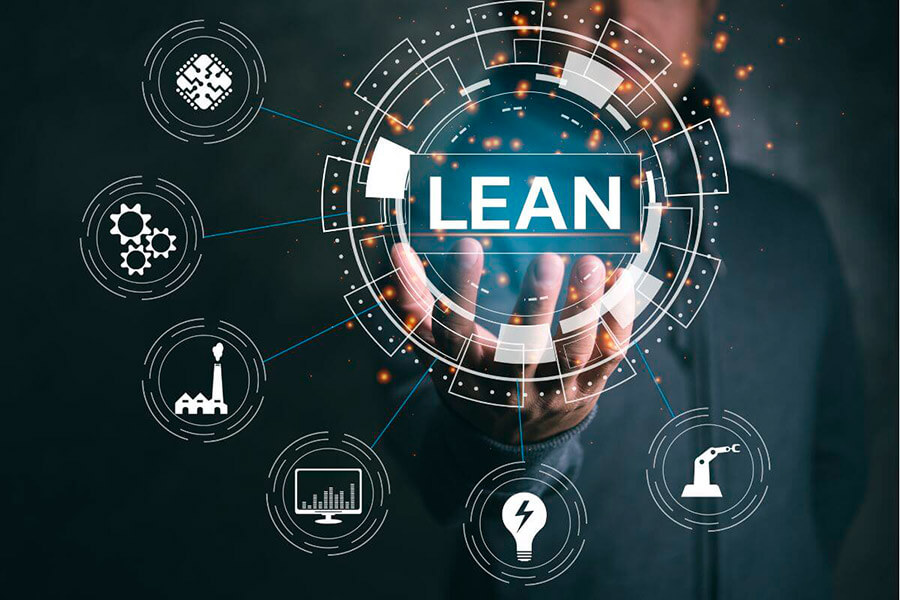Companies constantly strive to innovate, streamline operations, and deliver greater customer value. Achieving these goals requires a smart, efficient approach—and that’s where lean methodology becomes a game-changer. Rooted in efficiency and waste reduction, lean methodology provides a structured way to enhance productivity while maintaining customer satisfaction.
By adopting lean principles, businesses can unlock sustainable growth, uncover new opportunities, and foster a culture centered on continuous improvement. Whether on the factory floor or in the executive suite, lean methodology helps organizations focus on what truly matters—delivering value while optimizing processes and boosting profitability.
Fundamentals of Lean Methodology
The lean methodology started with the Toyota Production System in the mid-20th century. It focused on eliminating waste, using resources wisely, and giving customers the best value. Over time, lean thinking has grown and is used in many industries, changing how businesses work today.
Origins and Evolution of Lean Thinking
Lean’s roots are in the post-World War II era. Toyota, with limited resources and tough competition, wanted to change its manufacturing. Leaders like Taiichi Ohno and Shigeo Shingo created a system focused on efficiency, quality, and meeting customer needs. This “Toyota Way” became a global example of how to run a business well, inspiring others to follow lean management.
Core Philosophy Behind Lean Practices
Lean’s core is about making more value with less. It’s about finding perfection in every business area. By focusing on customers and always trying to get better, lean companies can make their operations smoother, work better, and offer top-notch products and services.
Key Components of Lean Implementation
To successfully implement lean, you need key parts like value stream mapping, just-in-time production, visual management, and a culture of continuous improvement. These work together to help companies find and fix problems, build a lean culture, and make lasting changes.
Benefits of Implementing Lean in Modern Business
Lean methodology offers immense benefits for today’s businesses. It focuses on customers’ needs, smooths processes, and cuts waste, leading to more productivity and efficiency.
Lean allows employees to do fewer things at a time and hold fewer meetings, allowing them to focus on tasks that really help customers.
One key advantage of lean is saving money. By eliminating unnecessary items, businesses use resources more efficiently and spend less. This allows them to offer better prices and make more money, helping them better serve customers.
Lean also means better quality and happier customers. It’s all about improving and putting customers first. This way, businesses can give what customers want, making them happier and more loyal.
Lean also makes work better for employees. It lets them solve problems and work together, making them happier and less likely to leave.
“Lean is not about doing more with less. It’s about doing better with what you have.”
Businesses can improve their work by focusing on customers, making things run smoothly, and continually improving. This will help them serve customers better and keep them coming back.
The Five Principles of Lean Methodology
Lean methodology is a powerful approach that helps businesses focus on what’s important. It aims to add value for customers by removing unnecessary tasks. At its core are five key principles that lead to better efficiency and effectiveness.
Value Definition from Customer Perspective
The heart of lean is understanding what customers value. Businesses can tailor their offerings by looking at what customers need and want. This focus on the customer helps eliminate waste and ensures resources are used wisely.
Value Stream Mapping
Lean practitioners map out the entire value stream from start to finish. This helps spot areas for improvement, like eliminating unnecessary steps. Value stream mapping is a key tool for smoother value flow to the customer.
Creating Continuous Flow
Lean aims for a smooth, uninterrupted flow of value. By reducing waste and delays, businesses can quickly deliver products or services. This continuous flow boosts productivity and makes businesses more responsive.
Establishing Pull Systems
Lean prefers a pull system over pushing products based on forecasts. This means production happens only when the customer needs it. It reduces waste and inventory, making businesses more agile and responsive to customer needs.
Pursuing Perfection
The last principle of lean is the pursuit of perfection. Lean organizations aim to find and remove all waste, always looking to improve. This continuous improvement is key to sustaining lean’s benefits and achieving long-term success.
Eliminating Waste: The Core of Lean Practice
Lean methodology focuses on eliminating waste, or “muda,” which is anything that doesn’t add value for the customer. By eliminating these non-value-added activities, businesses can better use their resources and finish projects quickly.
Lean helps companies examine their operations closely to identify waste. They see different types of waste, like making too much, waiting, moving things around, processing too much, having too much stock, unnecessary movement, and mistakes. By fixing these issues, companies can smoother their workflows, reduce wait times, and work more efficiently.
“The true value of a business is only manifested when there is no waste.” – Taiichi Ohno, Architect of the Toyota Production System.
The main idea of lean is to use resources wisely and cut waste. This helps companies identify and eliminate activities that don’t add value, making them more competitive and giving customers more value.
Lean Software Development: Adapting Methods for Digital Age
Software development teams are looking for ways to work better and faster. Lean software development offers a great solution. It helps teams keep up with rapid technological changes.
Agile and Lean Integration
Lean and agile methods work well together. They help teams focus on what customers want and work in small, flexible steps. This allows teams to cut waste, adapt quickly, and improve their software.
Software Development Value Stream
Lean software development considers the whole process, from start to finish. It helps teams see where they can improve and become more efficient. This way, every step adds value for the customer.
Minimizing Technical Debt
Lean software development aims for perfection. It focuses on keeping code clean and designs simple, maintaining agile teams, and ensuring they deliver great products.
Using lean software development can give teams a significant advantage in the digital world. It combines lean and agile, optimizes the process, and reduces technical debt. This leads to better work, faster responses, and happier customers.
Building a Customer-Focused Organization Through Lean
Lean methodology is more than smoothing processes and cutting waste. It’s a way to focus on the customer, ensuring everything we do adds value. By understanding what customers need, lean teams can make better choices that lead to growth and new ideas.
To build a lean organization that puts the customer first, we need to see things from their point of view. We map their journey, find out where they struggle, and listen to their feedback to improve. This approach creates a culture where everyone cares about how their work affects the customer.
“The customer’s perception of value is the true north for lean implementation. Every activity, resource, and decision should be laser-focused on meeting and exceeding customer needs.”
Keeping the customer in mind helps lean teams make their processes better. They might simplify things, automate tasks, or improve how they talk to customers. The aim is to remove anything that doesn’t help the customer so they can focus on innovation and getting better.
A lean approach focusing on the customer is key to a strong, flexible company. By putting the customer at the center, businesses can create unforgettable experiences. These experiences build loyalty, encourage word-of-mouth, and help the company grow.
Tools and Techniques for Lean Implementation
Lean methodology helps businesses become more efficient and commit to quality. It also empowers the team to keep improving. Lean uses practical tools and techniques to improve workflows and communication and support continuous learning.
Kanban Systems
Kanban systems are a key lean tool. They visually show work in progress, helping teams spot bottlenecks, manage priorities, and commit to quality work.
It makes teams work together better and respond quickly to changes.
Visual Management Boards
Visual management boards are key in lean. They clearly show important information like performance and progress, helping teams make better decisions and empowering them to track their work.
It makes everyone accountable and supports continuous learning.
Standard Work Procedures
Setting up standard work procedures is vital in lean. These procedures ensure that things are done the same way every time, helping reduce waste and improve efficiency.
By following best practices, teams can work better, make fewer mistakes, and stay productive.
Measuring Success in Lean Transformations
Using lean methods in a business is a smart move. It helps enable rapid, efficient project completion and optimize resources. It’s key to measure and check results to see if it works. Companies can see how well their lean efforts are doing by setting up key performance indicators (KPIs) and watching essential metrics.
Lead time reduction is a key metric. When companies smoothen their processes and eliminate waste, they can deliver faster. Also, seeing fewer defects and happier customers shows lean success.
Cost savings are another crucial area to watch. Optimizing resources and enabling rapid, efficient project completion can save money, which can be used for other essential things.
At the heart of good lean management is making decisions based on data. By monitoring and analyzing KPIs, businesses can make wise choices, find ways to improve, and ensure that their lean changes are working as planned.
Common Challenges and Solutions in Lean Adoption
Starting lean in a company comes with its own set of problems. One big issue is resistance to change from workers who want to keep their ways the same. It’s key to empower the team by teaching them new things to beat this. Show them how lean helps everyone do better. Building a culture that values commitment to quality gets everyone on board for good.
Keeping the momentum going is tough. The first buzz fades, and old habits creep back. Continuous learning and celebrating small wins motivate the team on the lean journey.
Scaling lean practices across big companies or different teams is hard. Make a solid plan, train well, and talk clearly. This ensures lean works everywhere and brings the best results.
“The essence of lean is to empower people, to have them take ownership of the process and improve it continuously.”
By tackling these common problems and finding good solutions, companies can implement lean work and unlock the full power of this method.
Real-World Success Stories and Case Studies
The lean methodology has changed businesses in many ways. It focuses on efficiency and customer focus. Let’s look at companies that have used this approach and seen great results.
Toyota Motor Corporation is a big name in lean manufacturing. They made their production smoother, reduced waste, and raised quality. They’re one of the top and most profitable car makers globally. Their dedication to improving and focusing on customer value is a model for others.
Intermountain Healthcare in Utah is another excellent example. They used lean to better patient care, lower medical mistakes, and work more efficiently. Their success has encouraged other healthcare groups to try lean, showing it works in many areas.
Conclusion
In conclusion, lean methodology is more than just a strategy—it’s a transformative way of thinking that drives efficiency, reduces waste, and enhances customer value.
You can foster a culture of continuous improvement and innovation by embedding lean principles into every aspect of your organization, from operations to leadership. This helps your business adapt to the fast-paced demands of today’s markets and positions you for long-term success by delivering better customer and stakeholder outcomes. Embracing lean isn’t just an improvement; it’s a competitive advantage.








